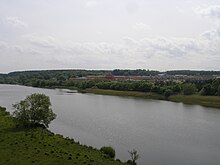River Bann
| River Bann | |
|---|---|

Overlooking the Lower Bann at Coleraine and the Riverside Retail Park on the eastern banks of the river
|
|
| Native name | An Bhanna |
| Country | Northern Ireland |
| Basin | |
| Main source | Slieve Muck, County Down |
| River mouth | Atlantic Ocean at Portstewart |
| Basin size | 5,775 square kilometres (2,230 sq mi) |
| Physical characteristics | |
| Length | 129 kilometres (80 mi) |
| Discharge |
|
| Features | |
| Tributaries |
|
The River Bann (Irish: an Bhanna, from ban-dea, meaning "goddess") is the longest river in Northern Ireland, its length, Upper and Lower Bann combined, being 129 km (80 mi). However, the total length of the River Bann, including its path through the 30 km (19 mi) long Lough Neagh is 159 km (99 mi). Another length of the River Bann given is 90 mi. The river winds its way from the southeast corner of Northern Ireland to the northwest coast, pausing in the middle to widen into the enormous Lough Neagh. The River Bann catchment has an area of 5,775 km2. The River Bann has a mean discharge rate of 92 m3/s. According to C.Michael Hogan, the Bann River Valley is a settlement area for some of the first human arrivals in Ireland after the most recent glacial retreat. The river has played an important part in the industrialisation of the north of Ireland, especially in the linen industry. Today salmon and eel fisheries are the most important economic features of the river. The river is often used as a dividing line between the eastern and western areas of Northern Ireland, often labelled the "Bann divide". Towns, councils and businesses "west of the Bann" are often seen as having less investment and government spending than those to the east. It is also seen as a religious, economic and political divide, with Catholics and Irish nationalists being in the majority to the west, and Ulster Protestants and unionists in the majority to the east; and with the financial and industrial capital of Greater Belfast to the east with the west of the Bann being more agricultural and rural.
The Lough Neagh catchment drains 43% of the land mass of Northern Ireland, as well as some border areas in the Republic of Ireland, all in Ulster. The Rivers Agency manages the water level in the lough using a barrage at Toome. The current drainage scheme was engineered by Major Percy Shepherd and was enabled by the Lough Neagh and Lower Bann Drainage and Navigation Act (Northern Ireland) 1955. The levels are regulated between 12.45 metres to 12.6 metres above Ordnance Datum, as defined in the Lough Neagh (Levels) Scheme 1955 (as amended).
...
Wikipedia
